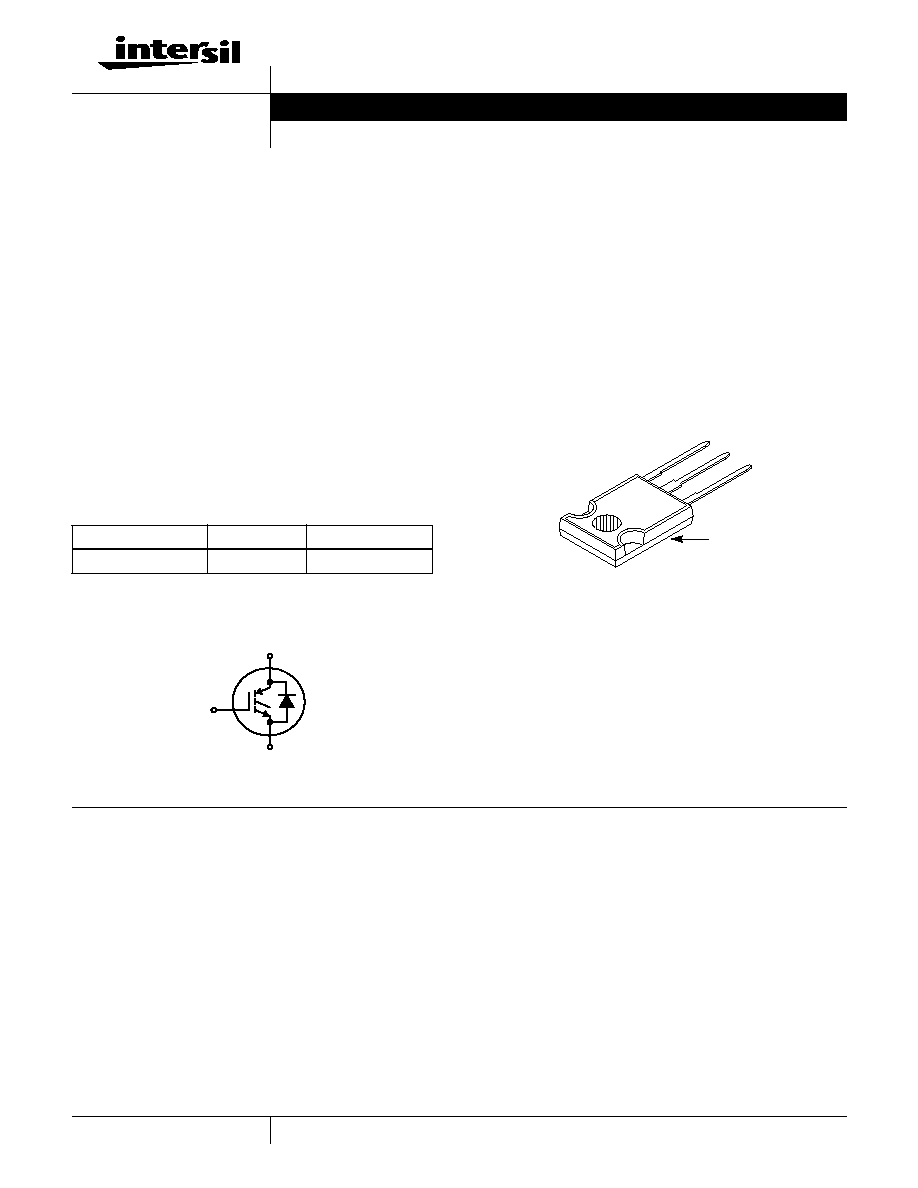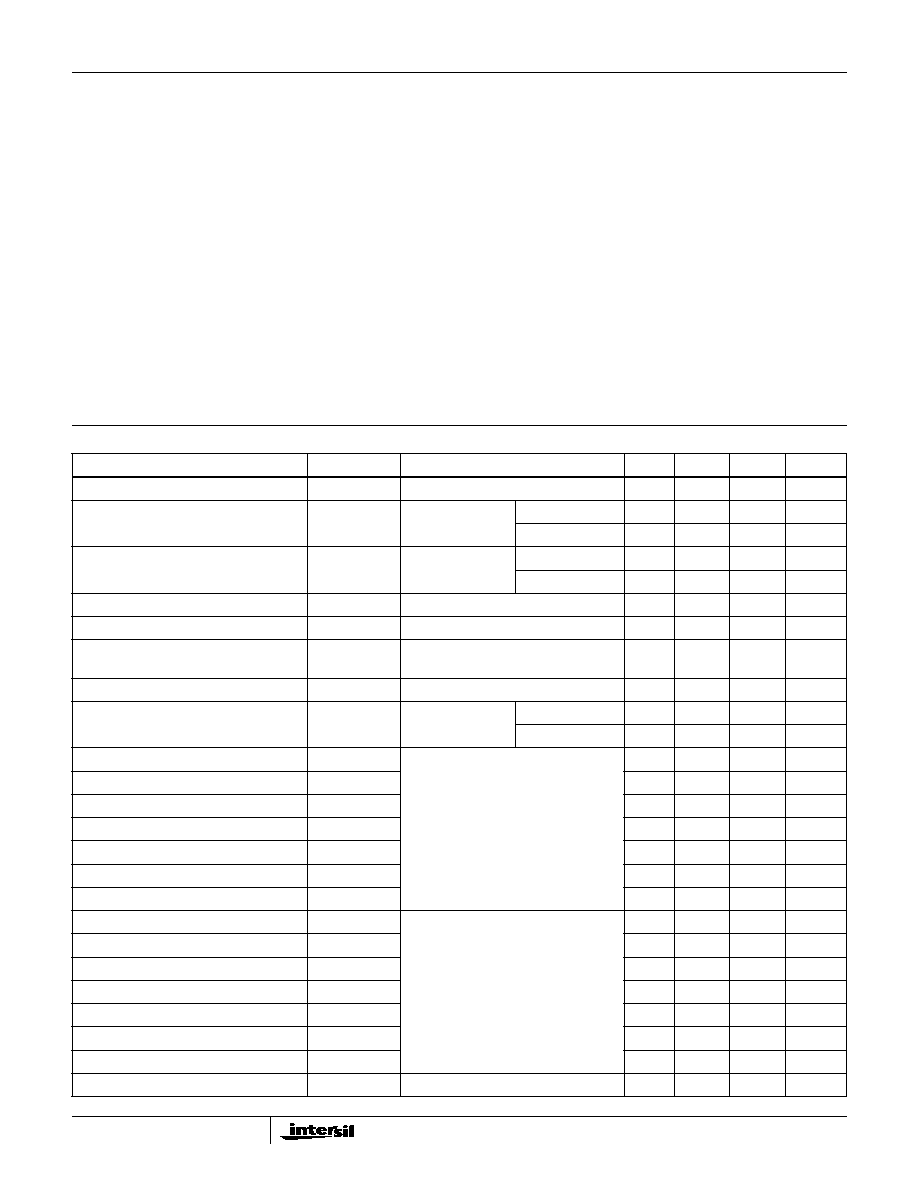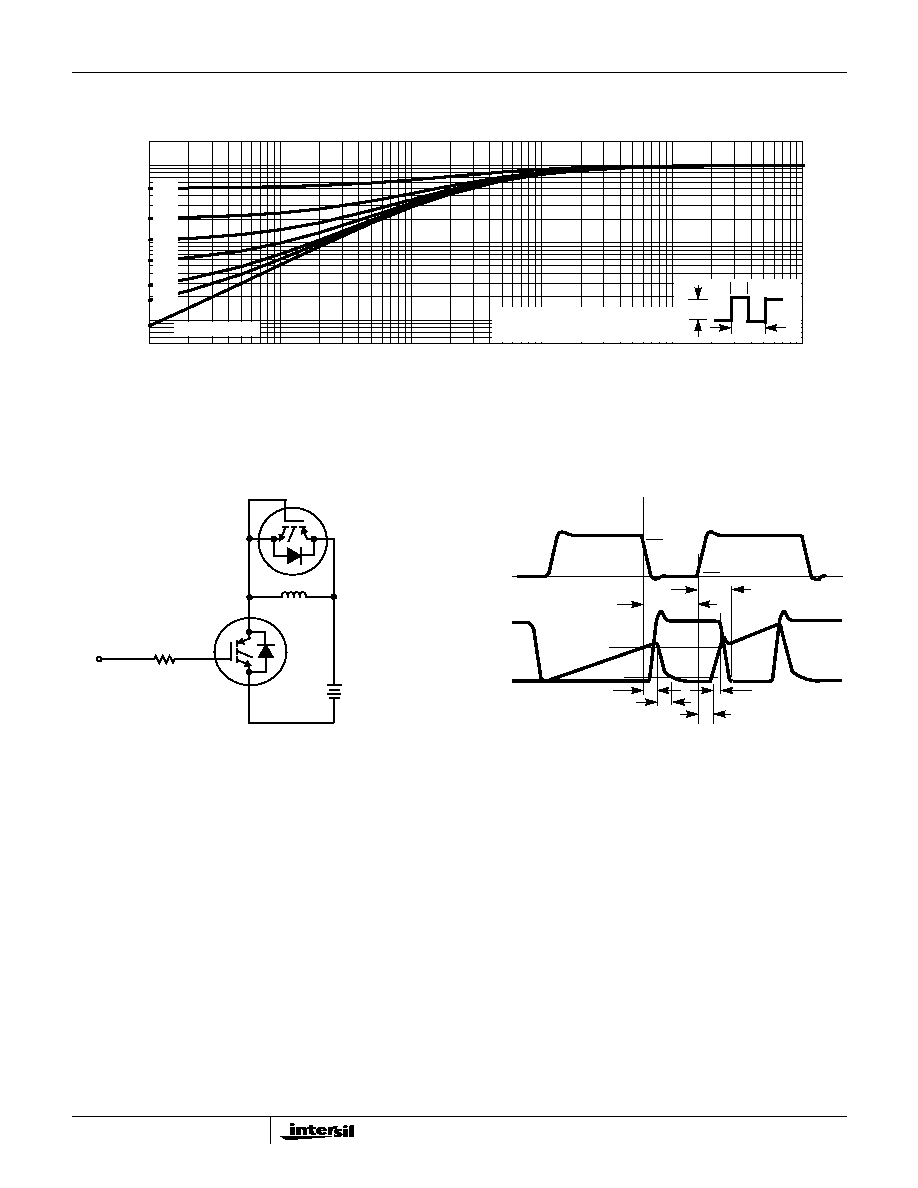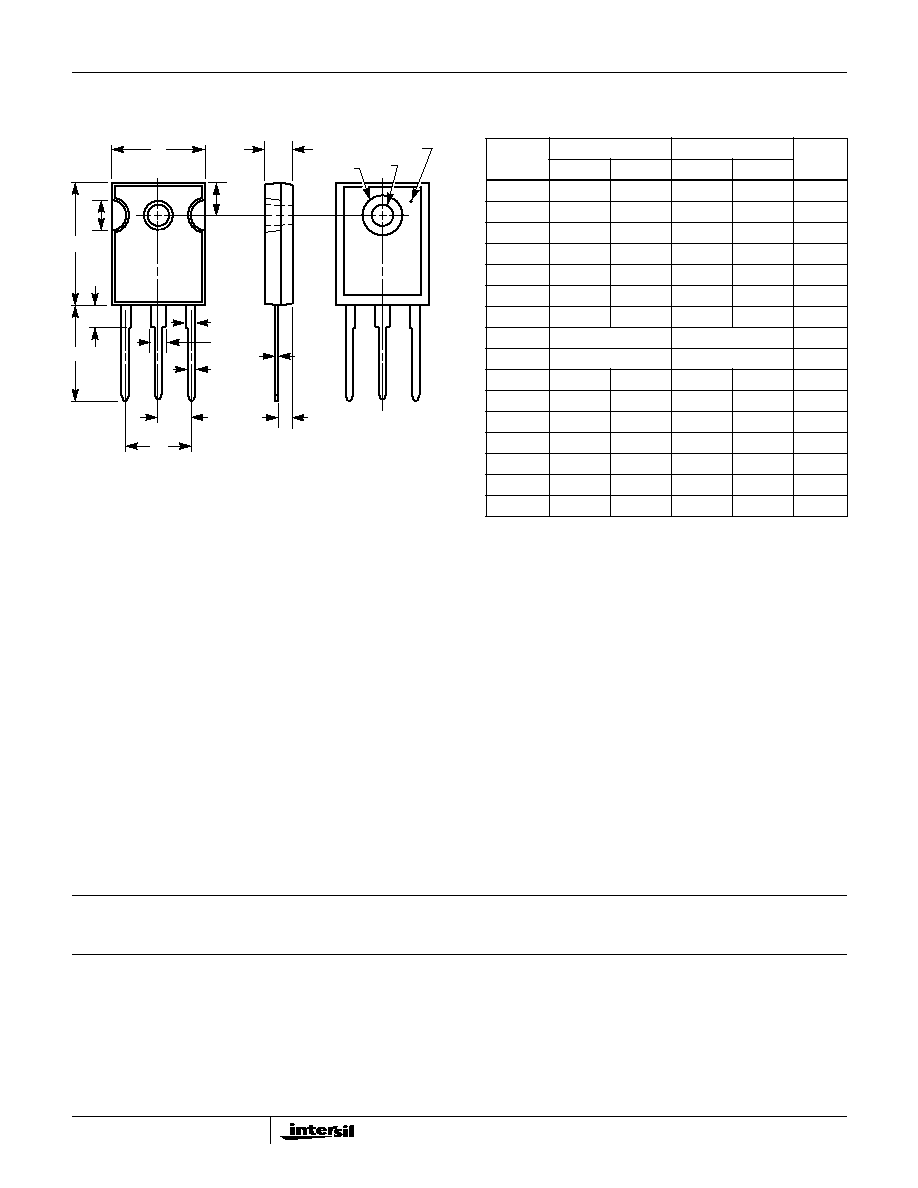
1
File Number
4790
CAUTION: These devices are sensitive to electrostatic discharge; follow proper ESD Handling Procedures.
1-888-INTERSIL or 407-727-9207
|
Copyright
©
Intersil Corporation 1999
SABERTM is a trademark of Analogy, Inc.
HGTG20N60A4D
600V, SMPS Series N-Channel IGBT with
Anti-Parallel Hyperfast Diode
The HGTG20N60A4D is a MOS gated high voltage
switching device combining the best features of MOSFETs
and bipolar transistors. This device has the high input
impedance of a MOSFET and the low on-state conduction
loss of a bipolar transistor. The much lower on-state voltage
drop varies only moderately between 25
o
C and 150
o
C. The
IGBT used is the development type TA49339. The diode
used in anti-parallel is the development type TA49372.
This IGBT is ideal for many high voltage switching
applications operating at high frequencies where low
conduction losses are essential. This device has been
optimized for high frequency switch mode power
supplies.
Formerly Developmental Type TA49341.
Symbol
Features
∑ >100kHz Operation At 390V, 20A
∑ 200kHz Operation At 390V, 12A
∑ 600V Switching SOA Capability
∑ Typical Fall Time . . . . . . . . . . . . . . . . . 55ns at T
J
= 125
o
C
∑ Low Conduction Loss
∑ Temperature Compensating SABERTM Model
www.intersil.com
Packaging
JEDEC STYLE TO-247
Ordering Information
PART NUMBER
PACKAGE
BRAND
HGTG20N60A4D
TO-247
20N60A4D
NOTE: When ordering, use the entire part number.
C
E
G
COLLECTOR
(FLANGE)
C
E
G
INTERSIL CORPORATION IGBT PRODUCT IS COVERED BY ONE OR MORE OF THE FOLLOWING U.S. PATENTS
4,364,073
4,417,385
4,430,792
4,443,931
4,466,176
4,516,143
4,532,534
4,587,713
4,598,461
4,605,948
4,620,211
4,631,564
4,639,754
4,639,762
4,641,162
4,644,637
4,682,195
4,684,413
4,694,313
4,717,679
4,743,952
4,783,690
4,794,432
4,801,986
4,803,533
4,809,045
4,809,047
4,810,665
4,823,176
4,837,606
4,860,080
4,883,767
4,888,627
4,890,143
4,901,127
4,904,609
4,933,740
4,963,951
4,969,027
Data Sheet
October 1999

2
Absolute Maximum Ratings
T
C
= 25
o
C, Unless Otherwise Specified
HGTG20N60A4D
UNITS
Collector to Emitter Voltage . . . . . . . . . . . . . . . . . . . . . . . . . . . . . . . . . . . . . . . . . . . . . .BV
CES
600
V
Collector Current Continuous
At T
C
= 25
o
C . . . . . . . . . . . . . . . . . . . . . . . . . . . . . . . . . . . . . . . . . . . . . . . . . . . . . . . . . I
C25
70
A
At T
C
= 110
o
C . . . . . . . . . . . . . . . . . . . . . . . . . . . . . . . . . . . . . . . . . . . . . . . . . . . . . . . I
C110
40
A
Collector Current Pulsed (Note 1) . . . . . . . . . . . . . . . . . . . . . . . . . . . . . . . . . . . . . . . . . . . I
CM
280
A
Gate to Emitter Voltage Continuous. . . . . . . . . . . . . . . . . . . . . . . . . . . . . . . . . . . . . . . . . V
GES
±
20
V
Gate to Emitter Voltage Pulsed . . . . . . . . . . . . . . . . . . . . . . . . . . . . . . . . . . . . . . . . . . . V
GEM
±
30
V
Switching Safe Operating Area at T
J
= 150
o
C (Figure 2) . . . . . . . . . . . . . . . . . . . . . . . SSOA
100A at 600V
Power Dissipation Total at T
C
= 25
o
C . . . . . . . . . . . . . . . . . . . . . . . . . . . . . . . . . . . . . . . . . P
D
290
W
Power Dissipation Derating T
C
> 25
o
C . . . . . . . . . . . . . . . . . . . . . . . . . . . . . . . . . . . . . . . . . .
2.32
W/
o
C
Operating and Storage Junction Temperature Range . . . . . . . . . . . . . . . . . . . . . . . . T
J
, T
STG
-55 to 150
o
C
Maximum Lead Temperature for Soldering . . . . . . . . . . . . . . . . . . . . . . . . . . . . . . . . . . . . . T
L
260
o
C
CAUTION: Stresses above those listed in "Absolute Maximum Ratings" may cause permanent damage to the device. This is a stress only rating and operation of the
device at these or any other conditions above those indicated in the operational sections of this specification is not implied.
NOTE:
1. Pulse width limited by maximum junction temperature.
Electrical Specifications
T
J
= 25
o
C, Unless Otherwise Specified
PARAMETER
SYMBOL
TEST CONDITIONS
MIN
TYP
MAX
UNITS
Collector to Emitter Breakdown Voltage
BV
CES
I
C
= 250
µ
A, V
GE
= 0V
600
-
-
V
Collector to Emitter Leakage Current
I
CES
V
CE
= 600V
T
J
= 25
o
C
-
-
250
µ
A
T
J
= 125
o
C
-
-
3.0
mA
Collector to Emitter Saturation Voltage
V
CE(SAT)
I
C
= 20A,
V
GE
= 15V
T
J
= 25
o
C
-
1.8
2.7
V
T
J
= 125
o
C
-
1.6
2.0
V
Gate to Emitter Threshold Voltage
V
GE(TH)
I
C
= 250
µ
A, V
CE
= 600V
4.5
5.5
7.0
V
Gate to Emitter Leakage Current
I
GES
V
GE
=
±
20V
-
-
±
250
nA
Switching SOA
SSOA
T
J
= 150
o
C, R
G
= 3
, V
GE
= 15V,
L = 100
µ
H, V
CE
= 600V
100
-
-
A
Gate to Emitter Plateau Voltage
V
GEP
I
C
= 20A, V
CE
= 300V
-
8.6
-
V
On-State Gate Charge
Q
g(ON)
I
C
= 20A,
V
CE
= 300V
V
GE
= 15V
-
142
162
nC
V
GE
= 20V
-
182
210
nC
Current Turn-On Delay Time
t
d(ON)I
IGBT and Diode at T
J
= 25
o
C,
I
CE
= 20A,
V
CE
= 390V,
V
GE
= 15V,
R
G
= 3
,
L = 500
µ
H,
Test Circuit Figure 24
-
15
-
ns
Current Rise Time
t
rI
-
12
-
ns
Current Turn-Off Delay Time
t
d(OFF)I
-
73
-
ns
Current Fall Time
t
fI
-
32
-
ns
Turn-On Energy (Note 3)
E
ON1
-
105
-
µ
J
Turn-On Energy (Note 3)
E
ON2
-
280
350
µ
J
Turn-Off Energy (Note 2)
E
OFF
-
150
200
µ
J
Current Turn-On Delay Time
t
d(ON)I
IGBT and Diode at T
J
= 125
o
C,
I
CE
= 20A,
V
CE
= 390V, V
GE
= 15V,
R
G
= 3
,
L = 500
µ
H,
Test Circuit Figure 24
-
15
21
ns
Current Rise Time
t
rI
-
13
18
ns
Current Turn-Off Delay Time
t
d(OFF)I
-
105
135
ns
Current Fall Time
t
fI
-
55
73
ns
Turn-On Energy (Note 3)
E
ON1
-
115
-
µ
J
Turn-On Energy (Note 3)
E
ON2
-
510
600
µ
J
Turn-Off Energy (Note 2)
E
OFF
-
330
500
µ
J
Diode Forward Voltage
V
EC
I
EC
= 20A
-
2.3
-
V
HGTG20N60A4D

3
Diode Reverse Recovery Time
t
rr
I
EC
= 20A, dI
EC
/dt = 200A/
µ
s
-
35
-
ns
I
EC
= 1A, dI
EC
/dt = 200A/
µ
s
-
26
-
ns
Thermal Resistance Junction To Case
R
JC
IGBT
-
-
0.43
o
C/W
Diode
-
-
1.9
o
C/W
NOTE:
2. Turn-Off Energy Loss (E
OFF
) is defined as the integral of the instantaneous power loss starting at the trailing edge of the input pulse and ending
at the point where the collector current equals zero (I
CE
= 0A). All devices were tested per JEDEC Standard No. 24-1 Method for Measurement
of Power Device Turn-Off Switching Loss. This test method produces the true total Turn-Off Energy Loss.
3. Values for two Turn-On loss conditions are shown for the convenience of the circuit designer. E
ON1
is the turn-on loss of the IGBT only. E
ON2
is the turn-on loss when a typical diode is used in the test circuit and the diode is at the same T
J
as the IGBT. The diode type is specified in
Figure 20.
Electrical Specifications
T
J
= 25
o
C, Unless Otherwise Specified (Continued)
PARAMETER
SYMBOL
TEST CONDITIONS
MIN
TYP
MAX
UNITS
Typical Performance Curves
Unless Otherwise Specified
FIGURE 1. DC COLLECTOR CURRENT vs CASE
TEMPERATURE
FIGURE 2. MINIMUM SWITCHING SAFE OPERATING AREA
FIGURE 3. OPERATING FREQUENCY vs COLLECTOR TO
EMITTER CURRENT
FIGURE 4. SHORT CIRCUIT WITHSTAND TIME
T
C
, CASE TEMPERATURE (
o
C)
I
CE
, DC COLLECT
OR CURRENT (A)
50
20
0
80
40
60
25
75
100
125
150
100
V
GE
= 15V
PACKAGE LIMIT
DIE CAPABILITY
V
CE
, COLLECTOR TO EMITTER VOLTAGE (V)
700
60
0
I
CE
, COLLECT
OR T
O
EMITTER CURRENT (A)
20
300
400
200
100
500
600
0
80
100
40
120
T
J
= 150
o
C, R
G
= 3
, V
GE
= 15V, L = 100
µ
H
f
MAX
, OPERA
TING FREQ
UENCY (kHz)
5
I
CE
, COLLECTOR TO EMITTER CURRENT (A)
40
300
50
10
20
500
T
J
= 125
o
C, R
G
= 3
, L = 500
µ
H, V
CE
= 390V
100
40
30
f
MAX1
= 0.05 / (t
d(OFF)I
+ t
d(ON)I
)
R
ÿJC
= 0.43
o
C/W, SEE NOTES
P
C
= CONDUCTION DISSIPATION
(DUTY FACTOR = 50%)
f
MAX2
= (P
D
- P
C
) / (E
ON2
+ E
OFF
)
T
C
V
GE
15V
75
o
C
V
GE
, GATE TO EMITTER VOLTAGE (V)
I
SC
, PEAK SHOR
T CIRCUIT CURRENT (A)
t
SC
, SHOR
T CIRCUIT WITHST
AND TIME (
µ
s)
10
11
12
15
0
2
10
100
250
350
450
14
13
14
4
6
8
12
150
200
300
400
V
CE
= 390V, R
G
= 3
, T
J
= 125
o
C
t
SC
I
SC
HGTG20N60A4D

4
FIGURE 5. COLLECTOR TO EMITTER ON-STATE VOLTAGE
FIGURE 6. COLLECTOR TO EMITTER ON-STATE VOLTAGE
FIGURE 7. TURN-ON ENERGY LOSS vs COLLECTOR TO
EMITTER CURRENT
FIGURE 8. TURN-OFF ENERGY LOSS vs COLLECTOR TO
EMITTER CURRENT
FIGURE 9. TURN-ON DELAY TIME vs COLLECTOR TO
EMITTER CURRENT
FIGURE 10. TURN-ON RISE TIME vs COLLECTOR TO
EMITTER CURRENT
Typical Performance Curves
Unless Otherwise Specified (Continued)
0
0.8
1.2
V
CE
, COLLECTOR TO EMITTER VOLTAGE (V)
I
CE
, COLLECT
OR T
O
EMITTER CURRENT (A)
0
20
40
1.6
2.0
3.2
80
60
T
J
= 125
o
C
T
J
= 150
o
C
PULSE DURATION = 250
µ
s
DUTY CYCLE < 0.5%, V
GE
= 12V
100
T
J
= 25
o
C
0.4
2.4
2.8
I
CE
, COLLECT
OR T
O
EMITTER CURRENT (A)
V
CE
, COLLECTOR TO EMITTER VOLTAGE (V)
DUTY CYCLE < 0.5%, V
GE
= 15V
PULSE DURATION = 250
µ
s
T
J
= 150
o
C
T
J
= 25
o
C
T
J
= 125
o
C
0
20
40
80
60
100
0
0.8
1.2
1.6
2.0
0.4
2.4
2.8
E
ON2
, TURN-ON ENERGY LOSS (
µ
J)
1000
600
I
CE
, COLLECTOR TO EMITTER CURRENT (A)
800
400
1200
0
15
10
20
25
30
35
40
T
J
= 125
o
C, V
GE
= 12V, V
GE
= 15V
R
G
= 3
, L = 500
µ
H, V
CE
= 390V
T
J
= 25
o
C, V
GE
= 12V, V
GE
= 15V
200
5
1400
600
I
CE
, COLLECTOR TO EMITTER CURRENT (A)
E
OFF
, TURN-OFF ENERGY LOSS (
µ
J)
0
100
400
200
500
700
800
T
J
= 25
o
C, V
GE
= 12V OR 15V
T
J
= 125
o
C, V
GE
= 12V OR 15V
300
R
G
= 3
, L = 500
µ
H, V
CE
= 390V
15
10
20
25
30
35
40
5
I
CE
, COLLECTOR TO EMITTER CURRENT (A)
t
d(ON)I
,
TURN-ON DELA
Y TIME
(ns)
8
14
16
18
20
22
15
10
20
25
30
35
40
5
T
J
= 25
o
C, T
J
= 125
o
C, V
GE
= 15V
T
J
= 25
o
C, T
J
= 125
o
C, V
GE
= 12V
R
G
= 3
, L = 500
µ
H, V
CE
= 390V
12
10
I
CE
, COLLECTOR TO EMITTER CURRENT (A)
t
rI
,
RISE TIME
(ns)
4
8
20
16
12
24
36
32
28
R
G
= 3
, L = 500
µ
H, V
CE
= 390V
T
J
= 25
o
C, T
J
= 125
o
C, V
GE
= 12V
T
J
= 25
o
C OR T
J
= 125
o
C, V
GE
= 15V
15
10
20
25
30
35
40
5
HGTG20N60A4D

5
FIGURE 11. TURN-OFF DELAY TIME vs COLLECTOR TO
EMITTER CURRENT
FIGURE 12. FALL TIME vs COLLECTOR TO EMITTER
CURRENT
FIGURE 13. TRANSFER CHARACTERISTIC
FIGURE 14. GATE CHARGE WAVEFORMS
FIGURE 15. TOTAL SWITCHING LOSS vs CASE
TEMPERATURE
FIGURE 16. TOTAL SWITCHING LOSS vs GATE RESISTANCE
Typical Performance Curves
Unless Otherwise Specified (Continued)
80
60
70
I
CE
, COLLECTOR TO EMITTER CURRENT (A)
t
d(OFF)I
, TURN-OFF DELA
Y TIME
(ns)
120
100
110
90
V
GE
= 12V, V
GE
= 15V, T
J
= 25
o
C
V
GE
= 12V, V
GE
= 15V, T
J
= 125
o
C
R
G
= 3
, L = 500
µ
H, V
CE
= 390V
15
10
20
25
30
35
40
5
I
CE
, COLLECTOR TO EMITTER CURRENT (A)
t
fI
, F
ALL TIME
(ns)
16
32
24
48
64
40
56
R
G
= 3
, L = 500
µ
H, V
CE
= 390V
72
80
15
10
20
25
30
35
40
5
T
J
= 125
o
C, V
GE
= 12V OR 15V
T
J
= 25
o
C, V
GE
= 12V OR 15V
I
CE
, COLLECT
OR T
O
EMITTER CURRENT (A)
0
80
120
7
8
9
10
12
V
GE
, GATE TO EMITTER VOLTAGE (V)
11
160
200
240
6
PULSE DURATION = 250
µ
s
DUTY CYCLE < 0.5%, V
CE
= 10V
T
J
= 125
o
C
T
J
= -55
o
C
T
J
= 25
o
C
40
V
GE
, GA
TE T
O
EMITTER V
O
L
T
A
GE (V)
Q
G
, GATE CHARGE (nC)
2
14
0
4
10
I
G(REF)
= 1mA, R
L
= 15
, T
J
= 25
o
C
V
CE
= 200V
6
8
12
16
V
CE
= 600V
20
40
60
80
120
100
140
160
0
I
G(REF)
= 1mA, R
L
= 15
, T
J
= 25
o
C
V
CE
= 400V
0
0.2
0.4
50
75
100
T
C
, CASE TEMPERATURE (
o
C)
0.6
1.0
125
25
150
1.8
0.8
E
TOT
A
L
, T
O
T
AL SWITCHING ENERGY LOSS (mJ)
1.4
1.2
1.6
I
CE
= 30A
I
CE
= 20A
E
TOTAL
= E
ON2
+ E
OFF
R
G
= 3
, L = 500
µ
H, V
CE
= 390V, V
GE
= 15V
I
CE
= 10A
0.1
10
100
R
G
, GATE RESISTANCE (
)
1
3
1000
E
TOT
A
L
, T
O
T
AL SWITCHING ENERGY LOSS (mJ)
10
T
J
= 125
o
C, L = 500
µ
H, V
CE
= 390V, V
GE
= 15V
E
TOTAL
= E
ON2
+ E
OFF
I
CE
= 10A
I
CE
= 20A
I
CE
= 30A
HGTG20N60A4D

6
FIGURE 17. CAPACITANCE vs COLLECTOR TO EMITTER
VOLTAGE
FIGURE 18. COLLECTOR TO EMITTER ON-STATE VOLTAGE
vs GATE TO EMITTER VOLTAGE
FIGURE 19. DIODE FORWARD CURRENT vs FORWARD
VOLTAGE DROP
FIGURE 20. RECOVERY TIMES vs FORWARD CURRENT
FIGURE 21. RECOVERY TIMES vs RATE OF CHANGE OF
CURRENT
FIGURE 22. STORED CHARGE vs RATE OF CHANGE OF
CURRENT
Typical Performance Curves
Unless Otherwise Specified (Continued)
V
CE
, COLLECTOR TO EMITTER VOLTAGE (V)
C, CAP
A
CIT
ANCE (nF)
0
20
40
60
80
100
0
1
3
4
5
2
FREQUENCY = 1MHz
C
IES
C
OES
C
RES
V
GE
, GATE TO EMITTER VOLTAGE (V)
8
9
1.7
10
12
1.8
2.0
1.9
11
13
14
15
16
2.1
2.2
V
CE
, COLLECT
OR T
O
EMITTER V
O
L
T
A
GE (V)
I
CE
= 30A
I
CE
= 20A
I
CE
= 10A
DUTY CYCLE < 0.5%, T
J
= 25
o
C
PULSE DURATION = 250
µ
s
0.5
1.0
1.5
2.5
3.0
I
EC
, FOR
W
ARD CURRENT (A)
V
EC
, FORWARD VOLTAGE (V)
0
2.0
0
10
15
20
25
25
o
C
125
o
C
5
30
PULSE DURATION = 250
µ
s
DUTY CYCLE < 0.5%,
60
40
20
0
t rr
, RECO
VER
Y TIMES (ns)
I
EC
, FORWARD CURRENT (A)
0
80
50
30
10
4
8
16
20
dI
EC
/dt = 200A/
µ
s
125
o
C trr
25
o
C tb
25
o
C ta
25
o
C trr
90
70
12
125
o
C ta
125
o
C tb
300
400
500
700
800
t
rr
, RECO
VER
Y TIMES (ns)
di
EC
/dt, RATE OF CHANGE OF CURRENT (A/
µ
s)
200
600
0
40
10
20
30
50
900
1000
I
EC
= 20A, V
CE
= 390V
125
o
C ta
125
o
C tb
25
o
C ta
25
o
C tb
600
400
200
0
Qrr
, REVERSE RECO
VER
Y CHARGE (nC)
di
EC
/dt, RATE OF CHANGE OF CURRENT (A/
µ
s)
1000
500
200
300
400
900
800
600
700
800
25
o
C, I
EC
= 10A
125
o
C, I
EC
= 20A
125
o
C, I
EC
= 10A
25
o
C, I
EC
= 20A
V
CE
= 390V
HGTG20N60A4D

7
FIGURE 23. IGBT NORMALIZED TRANSIENT THERMAL RESPONSE, JUNCTION TO CASE
Typical Performance Curves
Unless Otherwise Specified (Continued)
t
1
, RECTANGULAR PULSE DURATION (s)
Z
JC
,
NORMALIZED THERMAL RESPONSE
10
-2
10
-1
10
0
10
-5
10
-3
10
-2
10
-1
10
0
10
-4
t
1
t
2
P
D
DUTY FACTOR, D = t
1
/ t
2
PEAK T
J
= (P
D
X Z
JC
X R
JC
) + T
C
SINGLE PULSE
0.1
0.2
0.5
0.05
0.01
0.02
Test Circuit and Waveforms
FIGURE 24. INDUCTIVE SWITCHING TEST CIRCUIT
FIGURE 25. SWITCHING TEST WAVEFORMS
R
G
= 3
L = 500
µ
H
V
DD
= 390V
+
-
HGTG20N60A4D
DUT
DIODE TA49372
t
fI
t
d(OFF)I
t
rI
t
d(ON)I
10%
90%
10%
90%
V
CE
I
CE
V
GE
E
OFF
E
ON2
HGTG20N60A4D
ECCOSORBDTM is a trademark of Emerson and Cumming, Inc.

8
Handling Precautions for IGBTs
Insulated Gate Bipolar Transistors are susceptible to
gate-insulation damage by the electrostatic discharge of
energy through the devices. When handling these devices,
care should be exercised to assure that the static charge
built in the handler's body capacitance is not discharged
through the device. With proper handling and application
procedures, however, IGBTs are currently being extensively
used in production by numerous equipment manufacturers in
military, industrial and consumer applications, with virtually
no damage problems due to electrostatic discharge. IGBTs
can be handled safely if the following basic precautions are
taken:
1. Prior to assembly into a circuit, all leads should be kept
shorted together either by the use of metal shorting
springs or by the insertion into conductive material such
as "ECCOSORBDTM LD26" or equivalent.
2. When devices are removed by hand from their carriers,
the hand being used should be grounded by any suitable
means - for example, with a metallic wristband.
3. Tips of soldering irons should be grounded.
4. Devices should never be inserted into or removed from
circuits with power on.
5. Gate Voltage Rating - Never exceed the gate-voltage
rating of V
GEM
. Exceeding the rated V
GE
can result in
permanent damage to the oxide layer in the gate region.
6. Gate Termination - The gates of these devices are
essentially capacitors. Circuits that leave the gate open-
circuited or floating should be avoided. These conditions
can result in turn-on of the device due to voltage buildup
on the input capacitor due to leakage currents or pickup.
7. Gate Protection - These devices do not have an internal
monolithic Zener diode from gate to emitter. If gate
protection is required an external Zener is recommended.
Operating Frequency Information
Operating frequency information for a typical device
(Figure 3) is presented as a guide for estimating device
performance for a specific application. Other typical
frequency vs collector current (I
CE
) plots are possible using
the information shown for a typical unit in Figures 6, 7, 8, 9
and 11. The operating frequency plot (Figure 3) of a typical
device shows f
MAX1
or f
MAX2
; whichever is smaller at each
point. The information is based on measurements of a
typical device and is bounded by the maximum rated
junction temperature.
f
MAX1
is defined by f
MAX1
= 0.05/(t
d(OFF)I
+ t
d(ON)I
).
Deadtime (the denominator) has been arbitrarily held to 10%
of the on-state time for a 50% duty factor. Other definitions
are possible. t
d(OFF)I
and t
d(ON)I
are defined in Figure 25.
Device turn-off delay can establish an additional frequency
limiting condition for an application other than T
JM
. t
d(OFF)I
is important when controlling output ripple under a lightly
loaded condition.
f
MAX2
is defined by f
MAX2
= (P
D
- P
C
)/(E
OFF
+ E
ON2
). The
allowable dissipation (P
D
) is defined by P
D
= (T
JM
- T
C
)/R
JC
.
The sum of device switching and conduction losses must not
exceed P
D
. A 50% duty factor was used (Figure 3) and the
conduction losses (P
C
) are approximated by
P
C
= (V
CE
x I
CE
)/2.
E
ON2
and E
OFF
are defined in the switching waveforms
shown in Figure 25. E
ON2
is the integral of the
instantaneous power loss (I
CE
x V
CE
) during turn-on and
E
OFF
is the integral of the instantaneous power loss
(I
CE
x V
CE
) during turn-off. All tail losses are included in the
calculation for E
OFF
; i.e., the collector current equals zero
(I
CE
= 0).
HGTG20N60A4D

9
All Intersil semiconductor products are manufactured, assembled and tested under ISO9000 quality systems certification.
Intersil semiconductor products are sold by description only. Intersil Corporation reserves the right to make changes in circuit design and/or specifications at any time with-
out notice. Accordingly, the reader is cautioned to verify that data sheets are current before placing orders. Information furnished by Intersil is believed to be accurate and
reliable. However, no responsibility is assumed by Intersil or its subsidiaries for its use; nor for any infringements of patents or other rights of third parties which may result
from its use. No license is granted by implication or otherwise under any patent or patent rights of Intersil or its subsidiaries.
For information regarding Intersil Corporation and its products, see web site www.intersil.com
Sales Office Headquarters
NORTH AMERICA
Intersil Corporation
P. O. Box 883, Mail Stop 53-204
Melbourne, FL 32902
TEL: (407) 724-7000
FAX: (407) 724-7240
EUROPE
Intersil SA
Mercure Center
100, Rue de la Fusee
1130 Brussels, Belgium
TEL: (32) 2.724.2111
FAX: (32) 2.724.22.05
ASIA
Intersil (Taiwan) Ltd.
7F-6, No. 101 Fu Hsing North Road
Taipei, Taiwan
Republic of China
TEL: (886) 2 2716 9310
FAX: (886) 2 2715 3029
HGTG20N60A4D
TO-247
3 LEAD JEDEC STYLE TO-247 PLASTIC PACKAGE
IGBT Packaging Table
LEAD 1
- GATE
LEAD 2
- COLLECTOR
LEAD 3
- EMITTER
TERM. 4
- COLLECTOR
A
b
b
1
c
D
E
L
L
1
ÿR
1
2
e
1
3
1
J
1
ÿS
Q
ÿP
BACK VIEW
TERM. 4
3
e
b
2
2
SYMBOL
INCHES
MILLIMETERS
NOTES
MIN
MAX
MIN
MAX
A
0.180
0.190
4.58
4.82
-
b
0.046
0.051
1.17
1.29
2, 3
b
1
0.060
0.070
1.53
1.77
1, 2
b
2
0.095
0.105
2.42
2.66
1, 2
c
0.020
0.026
0.51
0.66
1, 2, 3
D
0.800
0.820
20.32
20.82
-
E
0.605
0.625
15.37
15.87
-
e
0.219 TYP
5.56 TYP
4
e
1
0.438 BSC
11.12 BSC
4
J
1
0.090
0.105
2.29
2.66
5
L
0.620
0.640
15.75
16.25
-
L
1
0.145
0.155
3.69
3.93
1
ÿP
0.138
0.144
3.51
3.65
-
Q
0.210
0.220
5.34
5.58
-
ÿR
0.195
0.205
4.96
5.20
-
ÿS
0.260
0.270
6.61
6.85
-
NOTES:
1. Lead dimension and finish uncontrolled in L
1
.
2. Lead dimension (without solder).
3. Add typically 0.002 inches (0.05mm) for solder coating.
4. Position of lead to be measured 0.250 inches (6.35mm) from bottom
of dimension D.
5. Position of lead to be measured 0.100 inches (2.54mm) from bottom
of dimension D.
6. Controlling dimension: Inch.
7. Revision 1 dated 1-93.








